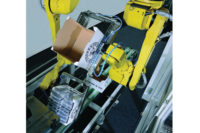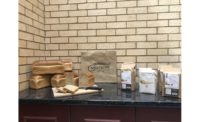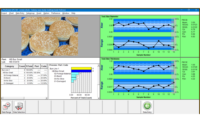
No matter how the cookie crumbles, Old Colony Baking Co. has what it takes to be a winner in the cookie, brownie and sweet goods business. Its brands includeMussleman’s, Diamond (Walnuts), ReaLemonand Old Colony’s ownCarnival animal cracker label, packed in 1- and 2-oz. laminated filmstock bags brightly printed with contemporary graphics. Residing in what was once a small bakery decades ago, Old Colony Baking shares space with its sister company and contract baking/packing facility, Spring Valley Baking Co., which churns out gourmet fudge brownies, tart and tangy lemon bars and chocolate chip bars under theOld Colonybrand and other well-known licensing partner brands.
Actually, the cookies themselves are made and packaged offsite at another nearby contract-baking facility called Cookie Kingdom. But the brownies are produced and packaged in-house by Spring Valley at the 11,000-sq.-ft facility that Jeffrey and Ann Kaufman bought and began operating in 2008. Home to approximately 28 employees, the tidy facility features a single, U-shaped production line, equipped with four horizontal form/fill/seal machines that generate more than 300 brownie bars per minute.
The brownies come in a 3 ¼-oz. size and a 2.7-oz. size as singles, and are sold in five-count multipacks that total 6.25 oz. “We can basically make any size for anyone,” says Jeffrey Kaufman, president of Spring Valley Baking Co. The cookies are packed for various market channels in 1-oz. bags for airlines and foodservice and 2-oz. bags for vending and convenience stores and soon, a 5-oz. bag for grocery channels.
“We found this building in Spring Valley, which used to be a cookie plant about 20 years ago,” remembers Kaufman. “It had been vacant for almost 20 years, so we started a rehab; however, what was supposed to be a three-month project turned into two years. We had to start from scratch and gut the entire facility. Unfortunately, the two years took us right into the teeth of the economic slump.”
But that didn’t stop Kaufman, who, together with his wife, Ann, who is also chief executive officer of Old Colony Baking, transformed the facility into a brownie baking bonanza. Demand requires that the plant generate as much as 70,000-80,000 lb. of product each week or roughly 15,000-18,000 lb. of dough a day.
“There was a void in the market for brownies in 2008 when this opportunity came up,” he says. “After my work (about 25 years) at Plantation Baking, I was out of the brownie business for a while and there really was no packaged product like this available. So, loving what we used to do, we decided to get back into it,” he continues. “Our idea was, ‘let’s get this going and see if we have a viable business and if it works, we can always build a larger facility.’ My previous experience was invaluable, because I already knew the product, so we set out to see if we could come close to past success, and so far, so good. Our industry is small and the consolidation has been so heavy. Spring Valley’s niche is independent. There are currently several ‘irons in the fire,’ and we just have to wait for them to happen.”
Brownies aplenty
Nestled in the heart of corn country in Western Illinois, the bustling kosher- and pareve-certified plant doesn’t seem that it’s ever in a waiting mode. Running three to five days a week, 8.5 hours per shift, the facility produces more than 300 brownie packs a minute. “We try to run one product all day long-8.5 hours per shift. And then we do a full washdown,” Kaufman points out.
Ingredients are usually ordered on a just-in-time basis because of the facility’s limited storage space. “We have just one dock. All of our supplies come out of Chicago,” he adds. “And we use nothing but the highest quality ingredients-natural 10-12% butter fat cocoa, enriched flour, fresh eggs, natural invert sugar and pure chocolate chips.”
At the time ofSnack Food & Wholesale Bakery’s visit, Spring Valley Baking was producing-surprise!-gourmet fudge brownies under theOld Colonylabel. The shelf-stable brownies, wrapped in a printed film, stay fresh for 120 days.
“Old Colony is really a marketing and distribution company and the parent of Spring Valley Baking,” Kaufman explains. “Spring Valley Baking is purely a contract-baking company, and Old Colony was Spring Valley’s biggest customer when we first began.”
Mixing, extruding, topping
At the front end of the production line, flour, sugar, eggs, shortening, cocoa and other ingredients, which are stored near a bake shop area off the line, are added by hand into the plant’s single, stand-alone mixer from 50-lb. sacks or large liquid-dispensing totes. The mixer, which produces 1,000-lb. batches of brownie dough, is overseen by an operator who then dumps the mixed batter into a dough trough that is then hoisted overhead to the infeed hopper of a depositor/extruder that begins smoothing out the mixture onto a carbon steel band.
As the raw dough is smoothed and flattened out further, an operator adds the customer’s choice of topping, which can include semi-sweet chocolate chips, nuts, a mix of nuts and chips, sprinkles or nothing at all. At the time of our visit, a mix of chips and nuts were being applied. The extruder maintains a consistent dough thickness. “We’re currently awaiting the arrival of our new, automatic topping applicator,” he says. “This will provide labor savings and a uniform coverage of toppings on the brownies.”
The smooth, chocolate chip-topped dough then proceeds into the baking chamber of the company’s three-zone, direct-fired oven.
Each chamber of the oven has a top and bottom zone to evenly bake the brownies at temperatures in excess of 300ºF at a proprietary length of time. “Depending on the weather, we have to adjust our temperatures daily,” Kaufman says. “We monitor the dampers in all three zones and adjust accordingly.”
Inspection hatches at several intervals along the side of the oven can be opened by line operators during the baking process to visually check the progress of the run. After baking, the brownie dough continues to travel out of the oven into an ambient cooling system that removes as much of the heat as possible and continues on to a mesh cooling belt leading through a long cooling tunnel. Emerging from the cooling chamber, the dough is then slit lengthwise and is then automatically guillotine-cut into individual brownies as it continues to travels downline.
Wrapping and packing
The edges of the brownies are also trimmed to give them a nice, finished look, and the trimmed bars convey downline through a metal detector in to a set of four horizontal form/fill/seal machines. Line operators remove the individual brownies from the conveyor and gently place them into the infeed conveyor of the form/fill/seal machines, which use printed polypropylene film rollstock to wrap each brownie. A date coder also applies a manufacturer code and best-by date to each package.
Then, as the wrapped brownies emerge from the machines, operators group and place them into a chipboard display tray that holds a total of 12 bars each. “We don’t bulk-pack the wrapped brownies because they are very delicate and we don’t want them to get damaged en route,” Kaufman says. “The printed trays complement the brownie wraps, double as counter displays and are easy for the route people to handle.”
Meanwhile, operators perform quality control inspections on an hourly basis, taking moisture readings of the product, as well as making several visual checks. “But, in our business, there’s nothing like a visual check and a taste,” Kaufman smiles. The quality control staff also monitors dough deposit heights, dough temperatures, inspects packaging film codes and seal integrity and checks shipping case codes. Package weights are checked on a standalone scale every half hour.
Next, operators pack eight of the trays of brownies into cases for a total of 96 brownies per case. The cases are sent through an automatic taper and ink-jet coder, which applies a production and best-buy code and an item number to the sides of the cases. Each case is also labeled with a product identification sticker to facilitate storage and customer handling. The cases are then palletized by hand. The load is stretch-wrapped on an automatic stretch wrapper to secure the cases and is forklifted into the warehouse. “We maintain a bake-to-order philosophy,” says Kaufman. “We ask for a two-week leadtime, which gives us time to schedule, bake and ship so the customers get the freshest product available.”
Because the Spring Valley operation is only a few years old, changes to equipment haven’t been needed, though Kaufman says it will be nice to bring in the automatic topping applicator. “We’re still getting our legs underneath us after baking for almost two years.”
The facility and the Spring Valley team are nimble and can react to customer needs quickly and efficiently. “We’re flexible and can turn on a dime if need be,” Kaufman concludes. “That’s where the smaller independent companies have an edge over the larger, corporate facilities. It’s all about giving customers what they want. That’s our forte. We can make all kinds of brownies and like pastries, we can bake and package almost any size and weight a customer may want.”
Certainly, Kaufman, his wife, Ann and their crew enjoy what they do. They started the contract-baking facility to find out if was viable, and so far, it seems that it is.






